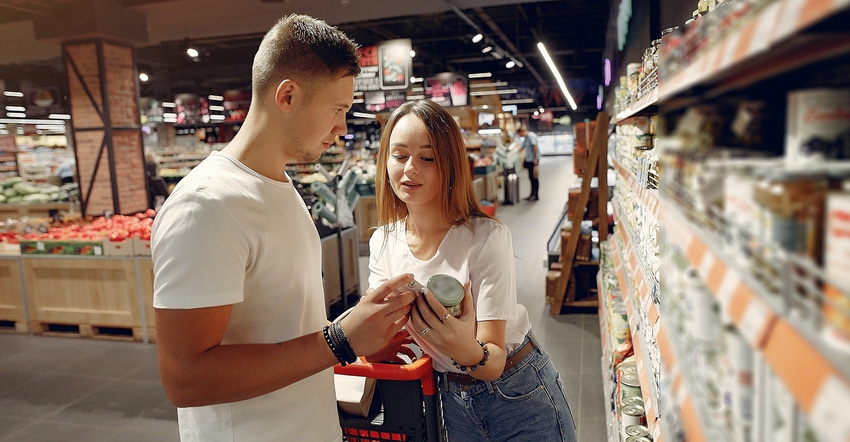Artificial intelligence (AI) can maximize food packaging transparency for consumers in the COVID-19 era.

A recent study found that only 28% of US shoppers admitted to having a good understanding of the salt, fat and sugar content in their foods, which signals there is an overwhelming number of Americans who lack awareness of the nutritional value of what they eat (see study). While some may argue that making the effort to know what ingredients make up your meal is down to the consumer, others believe the responsibility lies with manufacturers.
From immune-boosting foods to products that are responsibly sourced, consumers are more invested than ever about making choices with positive impacts for both their health and wellness, as well as the environment. The consumer demand for transparency has been driving change in the industry for years with some manufacturers going above and beyond to keep consumers informed. However, in the wake of COVID-19, more needs to be done.
Here are some practical steps manufacturers and retailers can apply to aid clarity and keep consumers informed.
Lift the lid on labeling.
In 2013, the horsemeat scandal (revealing undeclared ingredients had been mislabeled as beef) caused consumer outcry and led to an increased focus on standards and transparency by food safety authorities. The fallout from the scandal unsurprisingly had a negative impact on consumer trust for food producers and retailers and led to a greater demand for improvements.
Seven years on and the continued need to rebuild consumer confidence is still on the agenda for the retail sector, especially as shoppers’ tastes are continuously evolving as dietary requirements are changing. To name a few, consumers are searching for products that are meat-free, dairy-free, free-from, or organic.
Giving shoppers the power to easily read and understand what they are putting into their bodies is fundamental to help them manage their health and wellness goals. Many grocery retailers are internationally using the traffic light system to alert consumers of any high-intake ingredients, along with showing the fat, sugar, salt, and fat content etc. However, this will evolve in the future where shoppers will be looking at products that can help fight diseases - or could potentially increase the risk of sickness. For example, products that have low nutritional content that is high in sugar, saturated fats and are processed.

Pursue personalized packaging.
With consumers more conscious than ever about germs, smart packaging is not something to be overlooked. The purpose of packaging has always been to protect and preserve the food within its contents. However, with the advancements in Artificial Intelligence (AI) there’s a real opportunity for retailers to use smart packaging technology to improve food safety.
By leveraging consumer data collected via radio frequency identification (RFID) applications on product packaging, brands can work with retailers to help consumers overcome challenges faced when grocery shopping. The data can be used to create custom products in smaller batches to meet unique dietary needs, particularly as consumers continue to drop universal diets for individual ones and many look to food as medicine.
Predicted to grow to $52 billion by 2025, the smart packaging market has the potential to transform and enhance the consumer experience for the better through personalization. To successfully take ownership of the relationship with customers, retailers must use data collected from every consumer click to create meaningful experiences that go beyond the purchase of a specific product. An example of how this can be achieved is with the introduction of personalized reward systems that produce discounts, coupons, or loyalty points to incentivize shoppers to return.
Improve food discovery.
Research that looked into the eating habits of Americans found that 74% of people want to lead healthier lives, but only 1 in 4 believe grocery retailers are doing enough to support their health. Meanwhile, another study revealed overwhelming support (86%) for the notion that retailers should go above and beyond the current regulations to improve ingredient clarity. In addition, the data unveiled a general feeling among U.S. consumers for both on-trade and off-trade retailers to take more accountability.
With the pandemic driving an increase in online grocery sales, there is even more of a need from shoppers who can’t easily access customer service in-store, to be shown a variety of online products that can help with their individual health requirements. Retailers can aid consumers with healthy food search and discovery online through the use of tools which help to find the right foods for their specific needs.
New technology which champions personalization is available to retailers to help consumers filter faster, which aids convenience and garners happier customers. The use of such tools promote and support significant increases in conversion rates, basket size, return rates, and customer lifetime value.
Learn how to "chat" health with customers.
Another way AI can be used to keep consumers informed when grocery shopping is through the use of chatbots. According to one study, 79% of surveyed consumers revealed live chat is best for customer service. Smart chatbots, which imitate human responses in real-time, can be used to communicate with consumers and provide them with information about products, healthy recipes, and implement actions such as adding items to carts upon request.
Chatbots can also be put in place to support information campaigns to educate consumers and help retailers sell products. For example, if customers consistently have questions about the nutritional value of products, bots can be activated to deal with such requests, which also helps reduce the workload of customer service agents. The data collected from frequently asked and answered questions can then be used to help both retailers and manufacturers better understand consumer demand.
For consumers who prefer human interaction, in-store nutritionists can help support their wellness goals. Taking on this one-to-one advice works to promote retailers’ desires to offer outstanding customer service and consumers a personalized experience.
Pandemic-proof partnerships.
The outbreak of the Coronavirus has undoubtedly changed many aspects of life, and one area its impacted significantly is the importance of good health. Research by Unilever has shown that grocery shoppers are increasingly purchasing products that help boost their immune system, which is a trend that manufacturers and retailers should look to amplify in the journey to offer spotless transparency.
As diets diversify and consumers adopt exclusion diets — whether due to allergies or intolerances or simply a lifestyle choice — food manufacturers and retailers need to work together to cater to the highly educated consumer force who are searching for more than just flavor, texture, and cost-effectiveness.
Markus Stripf is CEO and Co-Founder of Spoon Guru, which harnesses artificial intelligence to improve food discovery.
About the Author(s)
You May Also Like




